Second Global RDH12 Scientific Conference Brings Clinical Trials Closer to Reality
The community of people living with Leber congenital amaurosis caused by mutations in the RDH12 gene moved closer to realizing the shared goal of establishing a clinical trial to find a treatment for the blinding disease.
More than 40 people gathered for the Second Global RDH12 Scientific Conference in Baltimore. The daylong meeting in November offered perspectives from clinicians, patients, parents, advocates, academia, regulators, and industry.
Silvia Cerolini, founder of Eyes on the Future, one of three organizations under the umbrella of the Global RDH12 Alliance, said the conference made tremendous progress toward a common goal: Designing a successful clinical trial to find a treatment to improve or stabilize vision in people living with RDH12. Current LCA13 RDH12 research is in preclinical stages, with the hope that the first clinical trials may start in 12 to 24 months.
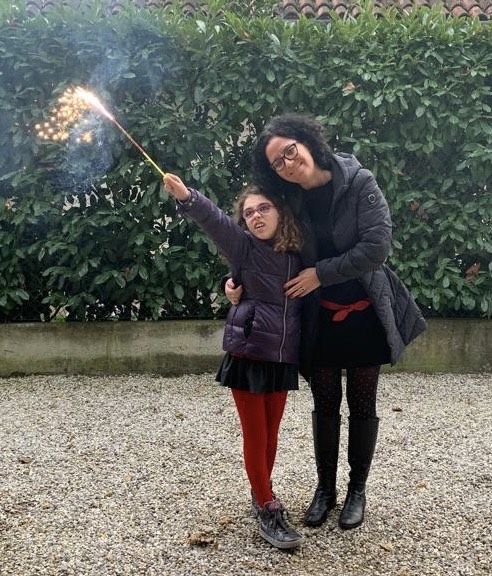
Silvia Cerolini and her 9-year-old daughter, Vicky
As one woman living with RDH12 voiced during the conference: “Any quantity of vision is everything for us.”
Cerolini, the mother of 9-year-old Vicky who lives with RDH12, submitted a scientific abstract based on the conference to ARVO, the Association for Research in Vision and Ophthalmology, discussing clinical trial designs and outcome measures for inherited retinal dystrophies (IRDs) associated with mutations in the RDH12 gene, one among 27 identified forms of LCA. She recently learned ARVO accepted her abstract as an example of patient-driven collaboration to accelerate research for presentation at the association’s April annual meeting in New Orleans.
In 2019, ARVO published the results of the First Global RDH12 Scientific Conference in its journal – Translational Vision Science & Technology. Families and scientists attending the conference in Columbia, Maryland, discussed therapy development for people with RDH12 mutations. The group developed three priorities: Proceed with a gene therapy clinical trial, assess data through natural history studies, and research the mechanisms of the disease.
This recent conference brought together an international group of scientific, medical, advocacy, and industry experts to identify and prioritize potential elements in designing a clinical trial and its key components: Outcome measures and endpoints.
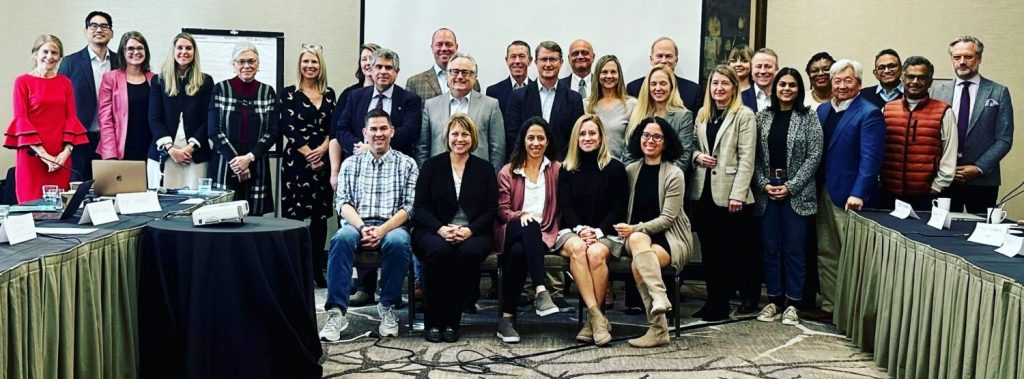
Participants in the Second Global RDH12 Scientific Conference
Outcome measures are used to assess a patient’s vision. Performed at the start of a clinical trial, the measures provide baseline information that can be compared with the same outcome measures done after an intervention or treatment, determining progress and efficacy.
Endpoints are outcome measures selected as the most relevant and clinically meaningful measurements that can be measured objectively to determine whether the intervention being studied is beneficial.
Selecting the most appropriate and patient-relevant outcome measures as endpoints for each specific IRD is a big challenge for the entire field of inherited retinal dystrophies.
The heterogeneity (diverseness) of IRD phenotypes (characteristics) poses significant challenges to understanding disease pathology, predicting treatment benefit, and selecting outcome measures and endpoints for clinical trials. Challenges in recent clinical trials failing to demonstrate treatment efficacy show the need for innovation in trial design and outcome measures’ selection.
Organizers cited four key challenges unique to treating RDH12 mutations: (1) Severe impairment of retina/vision from early life; (2) Uncertain expectations of stabilization/preservation versus improvement/restoration of vision; (3) Heterogeneity of the RDH12 phenotypes (and IRDs in general); and (4) Slow expected pace of detectable changes after treatment.
Coming Together for RDH12
The RDH12 Global Alliance comprises Eyes on the Future, based in the United Kingdom, RDH12 Fund for Sight in the United States, and Candle in the Dark in Belgium.
Retina International, Foundation Fighting Blindness, and Hope in Focus, partnered with the Alliance to present the conference and served as Patient Representatives. Director of Outreach and Development Courtney Coates attended on behalf of Hope in Focus, joining the Foundation’s CEO Jason Menzo, Todd A. Durham, PhD, and Claire M. Gelfman, PhD, and Retina International’s CEO Avril Daly.
Cerolini and Sue Lacey, PhD, of Astraea Medical Consulting, moderated the meeting.
Conference highlights included stories from people living with the disease and the constructive dialog among industry representatives, clinicians, scientists, and regulators, Coates said.
“Most significant were the RDH12 patients and parents sharing their experiences with progressive vision loss and their hopes for a treatment,” she said. “The day marked a meaningful step toward successful trials and, hopefully, will become a model as other gene-mutation studies progress to trials.”
For Maria Fiore, mother of 17-year-old Bella who lives with RDH12, the day brought hope.
“The input – from the academic side, opinions from the regulatory side, and the competitive nature of having multiple interests on the industry side – gives me a lot of hope that we’re getting closer to an RDH12 clinical trial,” said Fiore, a member of the Board of Directors for RDH12 Fund for Sight.
“We appear to be closer than ever, and events like the conference help to keep the motivation and drive to bring this to the finish line a real possibility.”
Bella and Vicky are part of the global RDH12 community that includes more than 200 families from 20 countries. Children and adults living with the rare inherited retinal disease hail from the United States, Europe, South America, China, India, and Russia.
The families communicate through Facebook and an email newsletter, with some local groups emerging to involve more people and remove language barriers.
The Global RDH12 Alliance organizes twice-yearly virtual community calls to review progress on clinical developments and discuss common challenges. Collectively, the three RDH12 organizations have raised more than $3.5 million since 2011 to advance research and find treatments.
Click here to see a video of people living with RDH12 introducing themselves.
Cerolini said it had been far from easy to wrestle all the participants down for one full day.
“But we came together as one big team to optimize the chances of trial success for our RDH12 community. There is still work to do to give Vicky and all our RDH12 community hope to see the world,” she said.
“It is not easy. But we are as close as ever to the first human clinical trials and we need to keep going. What we are learning about RDH12 can help the entire IRD field.”
Cerolini thanked Sue Lacey for her mastery in moderating the conference, and Francesca Sofia, PhD, and Giorgia Schena, PhD, both with Science Compass, for their preparation help. Consultants and partners also included Karmen Trzupek, MS, of RARE-X; Ebere Igboko, PhD, of Cure RP; Madhu Madhusudhan, PhD, of LifeArc; and Elin Haf Davies, PhD, of Aparito.
Patient Perspectives
The gathering watched a video of children and adults with RDH12 describing difficulties with sight loss and the hope that research will lead to a treatment.
Coates said people from several countries expressed their desires to have a chance to better their vision or at least maintain it.
“The heartfelt presentation reminded everyone in the room why we were there.”
Individuals and their families at the conference comprised a group of nine, sharing worldwide perspectives about trial design and outcome. They said they would accept stabilizing visual function as a “significant win” in the pursuit of a treatment.
Adult patients talked about the importance of keeping whatever light perception they have and shared stories of struggles in knowing where they are in their space, including the perils of bumping and bruising their foreheads when navigating spaces.
As one woman characterized the quest: “Any quantity of vision is everything for us.”
Their comments led to discussions with regulators and clinicians about the complexities of retinal function and the validity of certain endpoints and outcomes.
Along with Cerolini, family patient representatives included Jogin Desai from India, Sumaira Latif from the UK, Sylviane De Vel from Belgium, and Cecilia Vasconcelos from Brazil. The group also included RDH12 Fund for Sight representatives from the US: Mathew Pletcher, PhD, Allison Galloway, Lori Kinney, and Maria Fiore, all of whom are parents of children living with LCA13 RDH12.
Clinical and Academics Perspectives
Clinicians and academics shared unpublished data on RDH12 natural history and thought-provoking perspectives from the latest IRD trials.
Tomas S. Aleman, MD, PhD, presented insight from an RDH12-associated IRD natural history study and the latest expectations for treatment. He talked about differences between the LCA13 RDH12 and LCA2 RPE65 mutations, and the structural and functional relationship in the RDH12 mutation that causes central vision loss resulting in blurring.
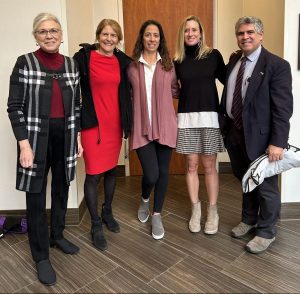
L-R: Debra A. Thompson, Jean Bennett, Maria Fiore, Allison Galloway, and Tomas S. Aleman
Despite functional and structural degradation of photoreceptors, he said, RDH12 gene therapy may have the potential to improve outcomes, even in adults, once certain toxins can be degraded.
Dr. Aleman is Professor of Ophthalmology and Director of the Hereditary Retinal Degeneration Clinics at the Scheie Eye Institute’s Perelman Center for Advanced Retinal and Ocular Therapeutics (CAROT) at the University of Pennsylvania.
***
Jean Bennett, MD, PhD, discussed outcomes and endpoints from studying the RPE65 gene mutation while developing voretigene neparvovec, known as LUXTURNA®, and whether they can be translated to RDH12 clinical trials.
The U.S. Food & Drug Administration (FDA) in 2017 approved LUXTURNA to help improve vision for people living with RPE65. The therapy remains the first and only approved ocular gene therapy and the only gene therapy treatment for any inherited disease in the United States.
The breakthrough treatment developed at Children’s Hospital of Philadelphia (CHOP) and Spark Therapeutics in Cambridge began with the successful treatment of a special being, Lancelot, the first in a line of Briard herding dogs, who helped drive research to bring the gene therapy to market.
Dr. Bennett told the group the development of a novel patient-relevant endpoint – a multi-luminance mobility test (MLMT) to measure functional vision, or how a person navigates in a vision-related activity across a range of light levels in daily living – was instrumental in demonstrating how voretigene neparvovec could improve vision in RPE65 patients, leading to LUXTURNA’s approval.
The navigational test, though, can be cumbersome and time-consuming, given the elaborate setup with lighting controls, videotaping, analysis, and such. Alternatively, researchers are working on virtual-reality tests, created as time-savers with more versatility. The task would be to design a functional vision test using a virtual-reality obstacle course.
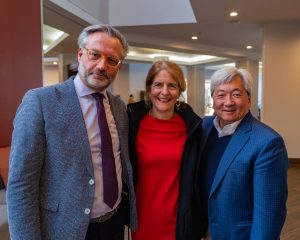
Drs. Bart P. Leroy, Jean Bennett, and Daniel C. Chung
Dr. Bennett is Professor of Ophthalmology at CAROT and the F.M. Kirby Emeritus Professor of Ophthalmology at the Perelman School of Medicine at UPenn.
***
Dr. Robert E. MacLaren, Professor of Ophthalmology at the University of Oxford, discussed lessons drawn from recent IRD clinical trials and vector delivery. He is working on a trial assessing the effects of retinal gene therapy with an adeno-associated viral (AAV) vector encoding genome particles.
LUXTURNA gene therapy employs a human-engineered AAV vector containing copies of a normal gene injected under the retina to express a protein necessary for vision.
Prof. MacLaren discussed opening the door to a new concept in the IRD space where researchers look for statistically significant improvements that show the vector is working and be more flexible in the immediate argument of whether that has a clinically significant improvement in that patient’s visual function, there and then.
Prof. MacLaren is the Consultant Ophthalmologist at Oxford Eye Hospital and the Consultant Vitreoretinal Surgeon at Moorfields Eye Hospital.
***
Professor Bart P. Leroy, MD, PhD, discussed information learned from recent IRD clinical trials and gene therapies in clinical practice.
He co-authored the PERCEIVE study that analyzed the Year 2 interim research on LUXTURNA, concluding the drug demonstrated safety and effectiveness when used in clinical practice following its regulatory approval. The study also identified a new adverse drug reaction called chorioretinal atrophy, causing inflammation in some patients. So far, the reaction has not affected visual function and will be tracked as the study progresses.
Dr. Leroy discussed the obstacles experienced by ProQR Therapeutics’ clinical trial of sepofarsen for LCA10 CEP290. Phase 2/3 of the Illuminate trial did not meet its primary endpoint of improving visual acuity. The European Medicines Agency (EMA) recommended an additional trial, prompting ProQR to seek a strategic partner to move the research forward.
He emphasized working toward shared goals and communicating with regulatory agencies on design and outcomes for IRD clinical trials. Saying children are not little adults, Dr. Leroy said questions about specific designs and patient-reported outcomes need to be adapted to the study population.
Dr. Leroy is Professor of Ophthalmology, Ophthalmic Genetics, and Visual Electrophysiology at Ghent University, and Head of the Ophthalmology Department at Ghent University Hospital, Ghent, Belgium.
***
Adam M. Dubis, PhD, Associate Professor, University College of London Institute of Ophthalmology Global Business School for Health, and Advanced Human Retinal Imaging Specialist at Moorfields Eye Hospital, presented information on work planned around data-driven solutions for RDH12 clinical trial support.
The clinician/academia group also included Mariya Moosajee, MD, PhD, Moorfields Eye Hospital; Debra A. Thompson, PhD, University of Michigan; Mark E. Pennesi, MD, PhD, Oregon Health & Science University; Abigail T. Fahim, MD, PhD, University of Michigan; Michel Michaelides, MD, PhD, Meira GTx; and Ramaswamy Subramanian, MD, PhD, Purdue University.
Industry Perspectives
Meira GTx CEO Robert K. Zeldin, MD, PhD, updated the group on the biotech’s RDH12 clinical development. The company is enrolling participants in the US, UK, and Europe for a natural history study and is planning a Phase 1/2 trial to assess safety and tolerability of potential gene therapy treatment.
Opus Genetics’ CEO Ben Yerxa, PhD, discussed capitalizing on key lessons in LUXTURNA’s development. Opus has three LCA-related projects in its pipeline, including one in early stages for RDH12. The company concentrates on preclinical projects in, or advancing toward, early-stage clinical trials to move research forward, with the goal of a successful trial or trials.
The conference’s industry group included: Jennifer Hunt, PhD, Erin C. O’Neil, PhD, and Sarah Tuller, JD, of Opus Genetics; Daniel L. Chao, MD, PhD, and Shannon E. Mullican, PhD, of Janssen Pharmaceutical Companies of Johnson & Johnson; Nicholas Gomm of Meira GTx; Daniel C. Chung, MD, PhD, of SparingVision; Shannon Blalock, PhD, of jCyte; and Aaron Osborne, MD, PhD, of Nanoscope Therapeutics.
Regulatory Perspectives
The FDA’s Dr. Wiley A. Chambers and the EMA’s Jane Moseley discussed trial-design parameters and outcome measures. They articulated their points of view, offering actionable advice on novel endpoints, including structural versus functional measures, virtual-reality mobility mazes, and patient-reported outcomes.
The FDA’s Ekaterini Tsilou, MD, and Jennifer M. Hammer, MD, also participated in the regulatory discussion.
Innovations in IRDs
Todd A. Durham, Foundation Fighting Blindness Sr. VP of Clinical & Outcomes Research, talked about Patient-Reported Outcome Measures (PROMS), questionnaires designed to capture how a patient feels or functions, without input or interpretation from anyone else.
PROMS are developed using qualitative information, such as experiences, priorities, and contextual information from well-defined patient populations. Durham described ways the information could help advance research into treatments for people living with RDH12 and other IRDs, and he recommended steps toward creating a draft PROM strategy to begin conversations with regulators and payors.
Elin Haf Davies, PhD, CEO of Aparito, presented information on patient-centered clinical outcome assessments and the importance of quality of life for people living with rare diseases, such as RDH12.
Attendee Perspectives
The conference, chock-full of experts in myriad aspects of working to find a treatment for people living with RDH12, manifested hope and excitement toward its goal of launching clinical trials. Here are a few reflections from people in attendance:
“The level of engagement and willingness to share knowledge, experiences, and perspectives from this multi-stakeholder group was inspiring and motivating,” Astraea’s Sue Lacey said. “And I’m sure this will translate into increased momentum and robust clinical development programs for RDH12.”
From Prof. Bart P. Leroy: “A big thank you for organizing a day that took RDH12-IRD patients considerably closer to gene therapy. The maturity and respect during the day allowed for an open and fruitful discussion.”
Dr. Daniel C. Chung with SparingVision thanked organizers for putting together a great meeting and said, “The free exchange of thoughts and points of view was incredibly enriching. We look forward to continuing this conversation and developing concrete solutions for further development until one day a patient will have the option of a treatment.”
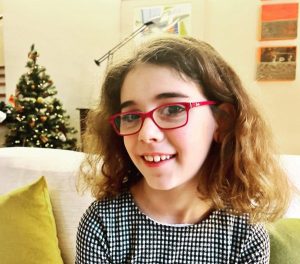
Vicky, Silvia Cerolini’s daughter
